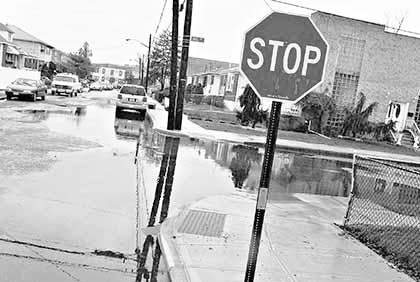
Flooding has been one of the main issues in various parts of Queens for the past several years, since the borough partially sits on a polluted aquifer that can’t be simply and safely drained. The New York City Department of Environmental Protection (DEP) recently announced that they will initiate the construction of a $40 million project to install an interceptor sewer in South Ozone Park in early 2015 designed to improve the capacity of the drainage system and reduce sewer overflows.
According to the DEP, the project is divided into two smaller projects in South Ozone Park under the Southern Belt Parkway. It aims to decrease the tremendous amounts of sewage overflow coming from both the Bergen Basin and Thurston Basin which empty directly into Jamaica Bay. The two projects will allow an additional 300 million gallons of combined sewer flow to be channeled to the Jamaica Wastewater Treatment Plant yearly. It will be treated in accordance to Federal Clean Water Act’s standards and regulations, instead of being discharged untreated into the tributaries of Jamaica Bay.
The Clean Water Act (CWA) establishes regulations for discharges of pollutants into the waters of the United States and quality standards for surface waters, according to the Environmental Protection Agency (EPA).
In the spring, the DEP said they plan on installing three hydraulic levees at key junction points within the area’s sewer network. They claim this will optimize the carrying capacity of the pipes during rain storms and reduce sewer overflows into both Bergen and Thurston Basins. The installation of the three hydraulic levees will further help reduce combined sewer overflows (CSO) into the Bergen Basin by 65 million gallons each year and into Thurston Basin by 102 million gallons a year, according to the DEP. They claim that the installation of the three levees should be completed by the summer of 2016 and the construction of the new interceptor sewer is expected to be finished in early 2017.
During York College’s “Green Talk” series in December 2014, DEP Deputy Commissioner Jim Roberts said that whenever it rains, flooding, sewer overflows and backups are issues the Queens community continually face. Roberts said the DEP is unable to treat both stormwater and sewer waste, so they have no other alternative but to release untreated water.
“I was trained to be a professional engineer, but I also have to realize that I live in a political environment as well,” Roberts said. “We have a lot of conversations to have with the elected officials in the areas that we serve, we work with them. It becomes one of the more challenging things that I have in my job.”
According to the DEP, there are two 36-inch sewer lines that transmit combined flow from North Conduit Avenue, under the Belt Parkway, to 150th Street and 126th Avenue, where it connects to a 72-inch sewer line which brings the flow to the Jamaica Wastewater Treatment Plant. As a result of the increasing growth and expansion in southern Queens, the twin 36-inch sewers no longer have sufficient capacity to carry the combined flow generated north of the Belt Parkway and act as a bottleneck in the area’s drainage system, DEP officials said.
When it rains heavily, the bottleneck causes CSOs to be discharged into the Bergen Basin. To avoid the bottleneck backup, the DEP said that they will build a parallel 48-inch sewer under the Belt Parkway, which is an estimated $29 million project. Since construction may interrupt flow of traffic on the Belt Parkway, the DEP said they will use a micro-tunneling machine to install the new sewer line in the fall. The machine will launch from a shaft site between North Conduit Avenue and the Belt Parkway and exit on the south end of the Belt Parkway.
The work will result in alternate closure of lanes on the Belt Parkway during the overnight hours and on weekends. The DEP said they will work with the Department of Transportation to inform the community and commuters of any closures or changes being made. They are expecting construction of the project to be completed in early 2017.
Like most cities, New York is serviced by a combined sewer system where stormwater from roofs, streets, and sidewalks, and the wastewater from homes and businesses are carried through a single sewer line to treatment plants. Problems arise during heavy rainfall when the treatment plants can’t handle the capacity and untreated water is released into the rivers and bays surrounding the city.
According to the DEP, there are 14 treatment plants in the city that can handle and treat all the wastewater created in NYC at an average of 1.3 billion gallons on a dry day to Federal Clean Water Act standards. They said over the past 10 years they have invested in over $10 billion in upgrading wastewater treatment plants and in reducing CSOs in NYC waterways.



1 Comment
I am glad to hear of this project to help with flooding in Southeast Queens. I live at 148 Avenue, between 231 and 232 streets in Springfield Gardens, Queens (11413 zipcode). I experienced extreme flooding with both Irene and Sandy. With Sandy I had 7 feet of water in my basement and 6 feet of surface water. How will my block/area benefit from this $40 million project. Only Ozone Park is mentioned in this article. I can assure you my area has more flooding issues. I am hopeful that my neighborhood has been considered as part of this project. I am grateful for any information you can provide.
Thank you.
Jennifer Warren